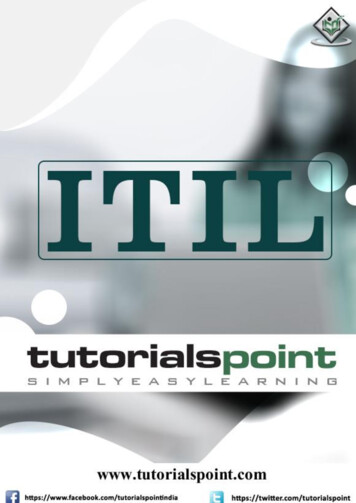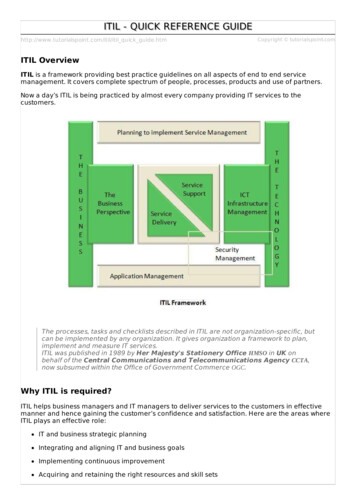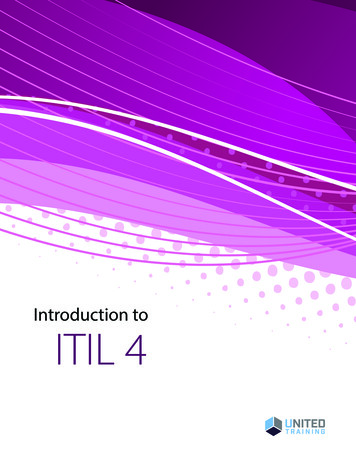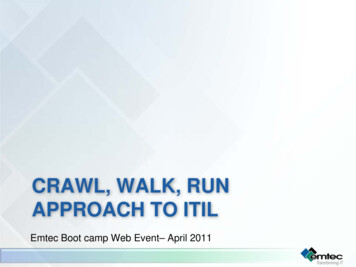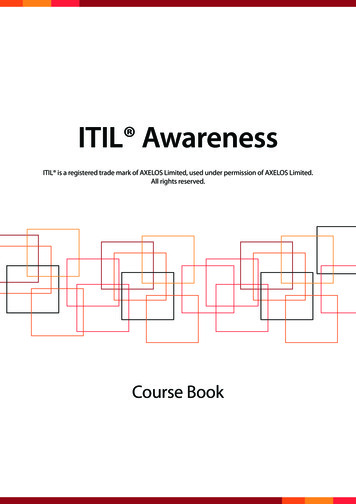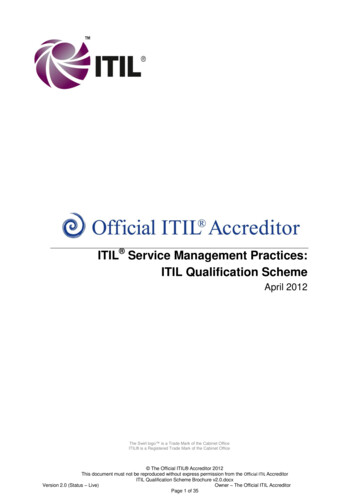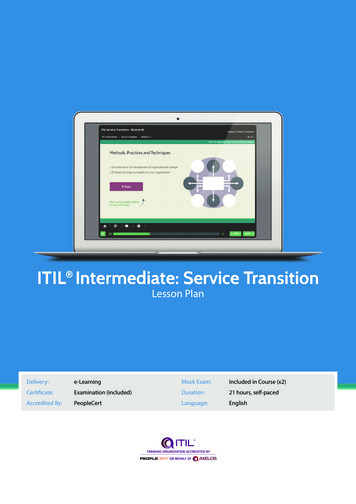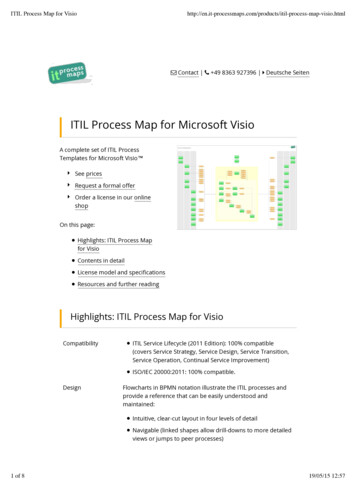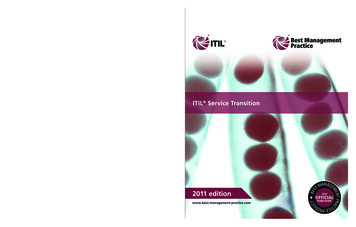
Transcription
Service providers must implement changes to support thechanging needs of the business. They must ensure that thesechanges deliver the value that the business expects, whileprotecting existing services from negative impacts. To dothis successfully requires efficient planning, so that new orchanged services can be delivered with the appropriatebalance of speed, cost and safety and with minimal disruptionto operations.ITIL Service Transition provides guidance on managingthe many aspects of service change, preventing undesiredconsequences while allowing for innovation. It is essentialreading for anyone seeking to deliver IT change with the bestpossible outcomes for the business.ITIL Service TransitionITIL Service Transition2011 editionBESwww.best-management-practice.comNT PRACME9 780113 313068ANAGETMTUCISBN 978-0-11-331306-8E PRODTIC7188 ITIL ST AN Cover V0 3.indd 1-311/07/2011 11:05
Published by TSO (The Stationery Office) and available from:Onlinewww.tsoshop.co.ukMail, Telephone, Fax & E-mailTSOPO Box 29, Norwich, NR3 1GNTelephone orders/General enquiries: 0870 600 5522Fax orders: 0870 600 5533E-mail: customer.services@tso.co.ukTextphone 0870 240 3701TSO@Blackwell and other Accredited AgentsCustomers can also order publications from:TSO Ireland16 Arthur Street, Belfast BT1 4GDTel 028 9023 8451 Fax 028 9023 5401 Crown Copyright 2011This is a Crown copyright value added product, reuse of which requires a Licence from theCabinet OfficeApplications to reuse, reproduce or republish material in this publication should be sent toThe Efficiency & Reform Group Service Desk, Cabinet Office, Rosebery Court, St Andrews BusinessPark, Norwich, Norfolk NR7 0HS Tel No: ( 44) (0)845 000 4999,E-mail: servicedesk@cabinet-office.gsi.gov.uk or complete the application form on the Cabinet Officewebsite, Licensing section.Copyright in the typographical arrangement and design is vested in The Stationery Office Limited.Applications for reproduction should be made in writing to The Stationery Office Limited, StCrispins, Duke Street, Norwich, NR3 1PD.The Swirl logo is a trade mark of the Cabinet OfficeITIL is a registered trade mark of the Cabinet OfficePRINCE2 is a registered trade mark of the Cabinet OfficeM o R is a registered trade mark of the Cabinet OfficeP3O is a registered trade mark of the Cabinet OfficeMSP is a registered trade mark of the Cabinet OfficeMoV is a trade mark of the Cabinet OfficeMoP is a trade mark of the Cabinet OfficeThe OGC Official Product endorsement logo is a trade mark of the Cabinet OfficeOGC (former owner of Best Management Practice) and its functions have moved into theCabinet Office part of HM Government - www.cabinetoffice.gov.ukFirst edition Crown Copyright 2007Second edition Crown Copyright 2011First published 2011ISBN 9780113313068Printed in the United Kingdom for The Stationery Office.Material is FSC certified and produced using ECF pulp.Sourced from fully sustainable forests.P002425500c707267 ITIL-ServiceTranslation v0 1.indd 207/1111/07/2011 15:41
ContentsList of figures vList of tables viiForeword viii5Preface ix2181Managing people through servicetransitions 197Introduction 11.1 Overview 35.3 Stakeholder management 2151.2 Context 6Organizing for service transition 2191.3 ITIL in relation to other publicationsin the Best Management Practiceportfolio 86.1 Organizational development 2216.2 Functions 2211.4 Why is ITIL so successful? 101.5 Chapter summary 106.3 Organizational context fortransitioning a service 222Service management as a practice 66.4 Roles 223136.5 Responsibility model – RACI 2342.1 Services and service management 156.6 Competence and training 2342.2 Basic concepts 226.7 Service transition relationship withother lifecycle stages 236Technology considerations 2397.1 Knowledge management tools 24272.4 The service lifecycle 30Service transition principles 357.2 Collaboration 2423.1 Policies for service transition 377.3 Configuration management system 243Implementing service transition 2453.2 Optimizing service transitionperformance 4544.7 Knowledge management 5.2 Managing organization andstakeholder change 2032.3 Governance and managementsystems 2731755.1 Managing communications andcommitment 199Acknowledgements xi14.6 Change evaluation 83.3 Service transition inputs and outputs 468.1 Key activities in the introduction ofservice transition 247Service transition processes 494.1 Transition planning and support 518.2 An integrated approach to servicetransition processes 2504.2 Change management 604.3 Service asset and configurationmanagement8.3 Implementing service transition ina virtual or cloud environment 250899Challenges, critical success factorsand risks 2534.4 Release and deploymentmanagement 1149.1 Challenges 2554.5 Service validation and testing 9.2 Critical success factors 2557267 ITIL-ServiceTranslation v0 1.indd 315011/07/2011 15:41
iv Contents9.3 Risks 2569.4 Service transition under difficultconditions 256Afterword 261Appendix A: Description of asset types lications268A.8Infrastructure268A.9Financial capital269C.12 Skills Framework for theInformation Age 286C.13 Carnegie Mellon: CMMI andeSCM framework 286C.14Balanced scorecard 286C.15Six Sigma 287Appendix D: Examples of inputs andoutputs across the service lifecycle 289References and further reading 293Abbreviations and glossary 297Index 339Appendix B: Risk assessmentand management 271B.1 Definition of risk and riskmanagement 273B.2Management of Risk (M o R) 273B.3ISO 31000 274B.4ISO/IEC 27001 275B.5Risk IT 276Appendix C: Related guidance 279C.1ITIL guidance and web services 281C2Quality management system 281C.3Risk management 282C.4Governance of IT 282C.5COBIT 282C.6 ISO/IEC 20000 service managementseries 283C.7 Environmental management andgreen/sustainable IT 283C.8 ISO standards and publications for IT 284C.9ITIL and the OSI framework 284C.10 Programme and projectmanagement 285C.11Organizational change 7267 ITIL-ServiceTranslation v0 1.indd 428511/07/2011 15:41
List of figuresFigure 1.1The ITIL service lifecycle 3Figure 1.2The scope of service transition 5Figure 1.3ITIL’s relationship with otherBest Management Practice guides Figure 2.1Conversation about the definitionand meaning of services Figure 4.9916Figure 2.2Logic of value creation throughservices 20Figure 2.3Sources of service managementpractice 21Figure 2.4Examples of capabilities andresources 23Figure 2.5Process model Figure 2.6The service portfolio and itscontents 27Figure 2.7Architectural layers of an SKMS 28Figure 2.8Plan-Do-Check-Act cycle 29Figure 2.9Integration across the servicelifecycle 32Figure 2.10 Continual service improvementand the service lifecycle Figure 4.1Scope of change managementand release and deploymentmanagement for services Figure 4.8233362Example of relationshipsbetween the CMS and SKMS 94Example of the application of thearchitectural layers of the CMS 96Figure 4.10 The relationship between thedefinitive media library and theconfiguration managementsystem 99Figure 4.11 Typical service asset andconfiguration managementactivity model 101Figure 4.12 Example of a configurationbreakdown for an end-usercomputing service 103Figure 4.13 Example of a configurationbreakdown for a managedvirtual system 103Figure 4.14 Example of service lifecycleconfiguration levels andbaseline points 108Figure 4.15 Simplified example of an ITinfrastructure 108Figure 4.16 Example of a configurationitem lifecycle 110Figure 4.17 Simplified example of releaseunits for an IT service 116Figure 4.2Example of a process flow for anormal change 70Figure 4.18 Architecture elements to be builtand tested 117Figure 4.3Example of a process flow forstandard deployment request Figure 4.19 Example of a release package 118Figure 4.20 Coordinating the deploymentof service components 119Figure 4.471Example of a process flow for astandard operational changerequest 71Figure 4.5Example of a changeauthorization model 78Figure 4.6Interfaces between changemanagement and service assetand configuration management Figure 4.787Example of a logicalconfiguration model 937267 ITIL-ServiceTranslation v0 1.indd 5Figure 4.21 Options for ‘big bang’ andphased deployment 120Figure 4.22 Phased deployment acrossgeographical locations 121Figure 4.23 Phases of release anddeployment management 123Figure 4.24 Example of service testingthrough service transition 13411/07/2011 15:41
vi List of figuresFigure 4.25 Example of a set ofdeployment activities 138Figure 4.26 Example of early life supportactivities 144Figure 4.27 Illustration of the benefits oftargeted early life support 145Figure 4.28 Dynamics of a service model 153Figure 4.29 Design constraints driven bystrategy 154Figure 4.30 Designing tests to cover a rangeof service assets, utilities andwarranties 162Figure 6.2Example of service transitionorganizational structure for alarger organization 222Figure 6.3Example of service transitionorganization and its interfaces 223Figure 6.4Organizational interfaces for aservice transition 224Figure 6.5Flow of experience 236Figure 8.1Steps to improving the servicetransition processes 247Figure 8.2An example of a path through theprocesses that might be requiredfor a single service transition 251Figure B.1The M o R framework Figure 4.32 Performing test activities – anexample 171Figure B.2ISO 31000 risk managementprocess flow 275Figure 4.33 Change evaluation process flow 177Figure B.3ISACA Risk IT process framework 277Figure 4.34 Context for qualification andvalidation activities 179Figure 4.35 The flow from data to wisdom 184Figure 4.36 Relationship of the CMDB, theCMS and the SKMS 185Figure 4.31 Example of a validation andtesting process 169274Figure 4.37 Examples of data and informationin the service knowledgemanagement system 186Figure 4.38 Contribution of knowledge toeffectiveness of support staff Figure 5.1Example of a communicationstrategy and plan contents 195201Figure 5.2Example of a communicationpath 202Figure 5.3Example of service transitionsteps for outsourcing 203Figure 5.4The emotional cycle of change 204Figure 5.5Potential stakeholders 216Figure 5.6Example of a stakeholder map 217Figure 5.7Power impact matrix 217Figure 5.8Example of a commitmentplanning chart 218Figure 6.1Example of service transitionorganizational structure for asmall organization 2227267 ITIL-ServiceTranslation v0 1.indd 611/07/2011 15:41
List of tablesTable 2.1Table 3.1Table 4.1Table 4.2Table 4.3The processes described in eachcore ITIL publication 31Service transition inputs andoutputs by lifecycle stage 46Table 5.4Example of a responsibility matrixfor release points during servicetransition 53Extract from a service releasepolicy for a retail organization 55Example of types of request byservice lifecycle stage 66Table 4.4Example of contents of changedocumentation 72Table 4.5Example of a change impact andrisk categorization matrix 75Table 4.6Change priority examples 76Table 4.7Configuration documentationfor assets and responsibilitiesthrough the service lifecycle Levels of configuration for buildand testing 125Table 4.9Questions to be answered whenplanning deployment 128Table 4.10Examples of service test models 157Table 4.11Service requirements, 1: improveuser accessibility and usability 158Table 4.12Examples of service managementmanageability tests 165Table 4.13Key terms that apply to thechange evaluation process Table 5.5Example of a feedback survey 211Table 5.6Tips for managing change 212Table 5.7J. P. Kotter’s ‘eight steps totransform your organization’ 213Table 6.1An example of a simple RACImatrix 234176Table 4.14Factors to consider when assessingthe effect of a service change 178Table 5.1Job characteristics that motivatepeople 203Table 5.2Understanding the culture ofthe parties involved 207Example of a RACI matrix formanaging change 2097267 ITIL-ServiceTranslation v0 1.indd 7210106Table 4.8Table 5.3Organizational role and skillsassessment checklist 11/07/2011 15:41
ForewordBack in the 1980s no one truly understood ITservice management (ITSM), although it wasclear that it was a concept that needed to beexplored. Hence a UK government initiative wasinstigated and ITIL was born. Over the years,ITIL has evolved and, arguably, is now the mostwidely adopted approach in ITSM. It is globallyrecognized as the best-practice framework. ITIL’suniversal appeal is that it continues to provide aset of processes and procedures that are efficient,reliable and adaptable to organizations of allsizes, enabling them to improve their own serviceprovision.ITIL is not a panacea to all problems. It is, however,a tried and tested approach that has been provento work.I wish you every success in your servicemanagement journey.Frances ScarffHead of Best Management PracticeCabinet OfficeIn the modern world the concept of havinga strategy to drive the business forward withadequate planning and design transitioning intoday-to-day operation is compelling. The aim ofservice transition is to make the move into thelive business environment as smooth as possible.This vital step in the service lifecycle ensures thatprocesses and procedures are in place to protectthe live operational environment, ensuring thatonly tested and planned services are enabledfor the business, in accordance with an agreedand communicated business timescale and withadequate fallback provision.The principles contained within ITIL ServiceTransition have been proven countless times in thereal world. We encourage feedback from businessand the ITSM community, as well as other expertsin the field, to ensure that ITIL remains relevant.This practice of continual service improvement isone of the cornerstones of the ITIL framework andthe fruits of this labour are here before you in thisupdated edition.There is an associated qualification scheme so thatindividuals can demonstrate their understandingand application of the ITIL practices. So whetheryou are starting out or continuing along the ITILpath, you are joining a legion of individuals andorganizations who have recognized the benefits ofgood quality service and have a genuine resolve toimprove their service level provision.7267 ITIL-ServiceTranslation v0 1.indd 811/07/2011 15:41
Preface‘They always say that time changes things, butyou actually have to change them yourself.’Andy WarholThis is the third book in the series of five ITILcore publications containing advice and guidancearound the activities and processes associated withthe five stages of the service lifecycle. The primarypurpose of the service transition stage of theservice lifecycle is to ensure that any modificationsor transitions to the live operational environment– affecting either new, modified, retiring or retiredservices – meet the agreed expectations of thebusiness, customers and users. This means that allmodifications to operational environments shouldbe managed, planned and coordinated throughservice transition processes and activities tofacilitate a smooth transition to live operation. Thiswill ensure that a new, modified, retiring or retiredservice fulfils its operational expectation and hasno or minimal adverse impact on customers, usersand the business.Successful service transition does not happen untilan organization recognizes the need for it and thebenefits it will bring. Effective service transitionis necessary because business operations andprocesses are in a constant state of transition. Thequest for competitive advantage, best-of-breedinnovation, agility and self-preservation are eternalcatalysts for changes that must ultimately bedelivered.Service transition ensures that the requirementsof service strategy encoded in service design areeffectively realized through to the delivery oflive services within the service operation stage ofthe service lifecycle. Service transition takes theoutputs from service design, the preceding stageof the lifecycle, and uses them to ensure thatservice solutions are smoothly migrated to liveoperation, fulfilling agreed customer and businessrequirements. The trigger for this transition activityis the production of a service design packageproduced by the processes and activities of servicedesign. Service transition takes this new businessrequirement contained within the service designpackage and, using the five aspects of design,creates services and their supporting practices7267 ITIL-ServiceTranslation v0 1.indd 9that meet business demands for functionality,security, performance, reliability and flexibility.The service design package facilitates the build,test, and release and deployment activities ofservice transition, and the operation, support andimprovement activities within the service operationand continual service improvement stages of theservice lifecycle.ITIL Service Transition is the IT service management(ITSM) professional’s guide to delivering thosechanges through transition lifecycle steps, whichhelp them to manage change in a broadercontext. Large-scale IT change is often driventhrough project or programme initiatives. Theseare mistakenly seen to be outside ‘changemanagement’ and too often not considered to bea service management concern until it is time toimplement them. Experience teaches us that thisapproach rarely yields the best possible benefit tothe business.Service transition also requires the effectivemanagement of knowledge, organizational cultureand transition in difficult or unusual circumstances.Every IT professional knows that the major part ofany change – that can make or break its success –is related to the human factor, especially culturalaversion to change.ITIL Service Transition supplies guidance onmanaging service transition from designedspecifications, dealing with change, configuration,test, release and deployment and every step inbetween. Effective service transition ensures thatmeeting business need, cost and efficiency areachieved with minimal risk, maximum optimizationand the highest degree of confidence possible.Contact informationFull details of the range of material publishedunder the ITIL banner can be found gement-ITIL/If you would like to inform us of any changes thatmay be required to this publication, please logthem at:11/07/2011 15:41
x For further information on qualifications andtraining accreditation, please visitwww.itil-officialsite.comAlternatively, please contact:APM Group – The Accreditor Service DeskSword HouseTotteridge RoadHigh WycombeBuckinghamshireHP13 6DGUKTel: 44 (0) 1494 458948Email: servicedesk@apmgroupltd.com7267 ITIL-ServiceTranslation v0 1.indd 1011/07/2011 15:41
Acknowledgements2011 editionWider teamAuthors and mentorsChange advisory boardStuart Rance (HP) AuthorColin Rudd (IT Enterprise Management Service Ltd(ITEMS)) MentorShirley Lacy (ConnectSphere) Project mentorAshley Hanna (HP) Technical continuity editorThe change advisory board (CAB) spentconsiderable time and effort reviewing all thecomments submitted through the change controllog and their hard work was essential to thisproject. Members of the CAB involved in thisreview included:Other members of the ITIL authoringteamDavid Cannon, Emily Egle, David Favelle, AshleyHanna, Kevin Holland, Stuart Rance, Frances Scarffand Sharon Taylor.Thanks are due to the authors and mentors whohave worked on all the publications in the lifecyclesuite and contributed to the content in thispublication and consistency across the suite. Theyare:David Cannon (HP), Lou Hunnebeck (ThirdSky), Vernon Lloyd (Fox IT), Anthony T. Orr(BMC Software), Randy Steinberg (MigrationTechnologies Inc.) and David Wheeldon (DavidWheeldon IT Service Management).Project governanceMembers of the project governance team included:Jessica Barry, APM Group, project assurance(examinations); Marianna Billington, itSMFI, senioruser; Emily Egle, TSO, team manager; JanineEves, TSO, senior supplier; Phil Hearsum, CabinetOffice, project assurance (quality); Tony Jackson,TSO, project manager; Paul Martini, itSMFI, senioruser; Richard Pharro, APM Group, senior supplier;Frances Scarff, Cabinet Office, project executive;Rob Stroud, itSMFI, senior user; Sharon Taylor,Aspect Group Inc., adviser to the project board(technical) and the ATO sub-group, and adviser tothe project board (training).For more information on the ATO sub-group inted.aspxFor a full list of acknowledgements of the ATOsub-group at the time of publication, pleasevisit: Acknowledgements.aspx7267 ITIL-ServiceTranslation v0 1.indd 11Once authors and mentors were selected for the2011 update, a revised CAB was appointed andnow includes:Emily Egle, David Favelle, Phil Hearsum, KevinHolland and Frances Scarff.ReviewersClaire Agutter, IT Training Zone; Niels Backx,Quint Wellington Redwood; Ernest R. Brewster,Independent; David M. Brink, Solutions3; JeroenBronkhorst, HP; Tony Brough, DHL Supply Chain;Erin Casteel, Veridity Pty Ltd; Janaki Chakravarthy,Independent; Christiane Chung Ah Pong, NCSPte Ltd, Singapore; Patrick Connelly, GartnerConsulting; Barry Corless, Global Knowledge;Federico Corradi, Cogitek; Jenny Dugmore, ServiceMatters; Frank Eggert, MATERNA GmbH; RobertFalkowitz, Concentric Circle Consulting; DavidFavelle, UXC Consulting/Lucid IT; Ryan Fraser, HP;Anne Goddard, Goddard Service ManagementConsulting; Vawns Guest, Pink Elephant; KevinHolland, NHS Connecting for Health; SteveIngall, iCore-ltd; Randy Johnson, IBM; GeorgeKinnear, The Grey Matters Education Ltd; BradLaatsch, HP; Chandrika Labru, Tata ConsultancyServices; Zoe Lambert, HP; Reginald Lo, ThirdSky; Jane McNamara, Lilliard Associates Ltd;Jeroen Moolhuijsen, Getronics Consulting; JuditPongracz, ITeal Consulting; Arvind Raman, InfosysTechnologies Ltd.; Peter Ravnholt, UXC Consulting/Lucid IT; Claudio Schicht, Independent; Noel Scott,Symantec; Arun Simha, L-3 CommunicationsSTRATIS; Hon P Suen, The Hong Kong Jockey11/07/2011 15:41
xii AcknowledgementsClub; Helen Sussex, Logica; J.R. Tietsort,Micron Technology; Claudia Tropp, TechnologyPartners International, Inc.; Ken Turbitt, ServiceManagement Consultancy (SMCG) Ltd; DeborahWagner, Booz Allen Hamilton; Chuck Wysocki,McKesson Corporation2007 EDITIONChief architect and authorsThanks are still due to those who contributedto the 2007 edition of Service Transition, uponwhich this updated edition is based.Sharon Taylor (Aspect Group Inc)Shirley Lacy (ConnectSphere)Ivor Macfarlane (Guillemot Rock)Chief architectAuthorAuthorAll names and organizations were correct atpublication in 2007.For a full list of all those who contributed to the2007 and 2011 editions of Service Strategy, ServiceDesign, Service Transition, Service Operation andContinual Service Improvement, please go onAcknowledgements.aspx
7267 ITIL-ServiceTranslation v0 1.indd 1411/07/2011 15:41
31 IntroductionITIL is part of a suite of best-practice publicationsfor IT service management (ITSM).1 ITIL providesguidance to service providers on the provision ofquality IT services, and on the processes, functionsand other capabilities needed to support them.ITIL is used by many hundreds of organizationsaround the world and offers best-practice guidanceapplicable to all types of organization thatprovide services. ITIL is not a standard that has tobe followed; it is guidance that should be readand understood, and used to create value for theservice provider and its customers. Organizationsare encouraged to adopt ITIL best practices and toadapt them to work in their specific environmentsin ways that meet their needs.key principles, required processes and activities,organization and roles, technology, associatedchallenges, critical success factors and risks. Theservice lifecycle uses a hub-and-spoke design, withservice strategy at the hub, and service design,transition and operation as the revolving lifecyclestages or ‘spokes’. Continual service improvementsurrounds and supports all stages of the servicelifecycle. Each stage of the lifecycle exerts influenceon the others and relies on them for inputs andfeedback. In this way, a constant set of checksand balances throughout the service lifecycleensures that as business demand changes withbusiness need, the services can adapt and respondeffectively.ITIL is the most widely recognized framework forITSM in the world. In the 20 years since it wascreated, ITIL has evolved and changed its breadthand depth as technologies and business practiceshave developed. ISO/IEC 20000 provides a formaland universal standard for organizations seeking tohave their service management capabilities auditedand certified. While ISO/IEC 20000 is a standard tobe achieved and maintained, ITIL offers a body ofknowledge useful for achieving the standard.In addition to the core publications, there is also acomplementary set of ITIL publications providingguidance specific to industry sectors, organizationtypes, operating models and technologyarchitectures.In 2007, the second major refresh of ITIL waspublished in response to significant advancementsin technology and emerging challenges for ITservice providers. New models and architecturessuch as outsourcing, shared services, utilitycomputing, cloud computing, virtualization, webservices and mobile commerce have becomewidespread within IT. The process-based approachof ITIL was augmented with the service lifecycleto address these additional service managementchallenges. In 2011, as part of its commitmentto continual improvement, the Cabinet Officepublished this update to improve consistency acrossthe core publications.The ITIL framework is based on the five stagesof the service lifecycle as shown in Figure 1.1,with a core publication providing best-practiceguidance for each stage. This guidance includes1 ITSM and other concepts from this chapter are described in more detailin Chapter 2.7267 ITIL-ServiceTranslation v0 1.indd 151.1 OverviewITIL Service Transition provides best-practiceguidance for the service transition stage of the ITILservice lifecycle. Although this publication can icestrategyServicedesignServiceoperationFigure 1.1 The ITIL service lifecycle11/07/2011 15:41
4 Introductionread in isolation, it is recommended that it is usedin conjunction with the other core ITIL publications.1.1.1 Purpose and objectives of servicetransitionThe purpose of the service transition stage of theservice lifecycle is to ensure that new, modifiedor retired services meet the expectations of thebusiness as documented in the service strategy andservice design stages of the lifecycle.planning, building, testing, evaluation anddeployment. The publication also considers serviceretirement and transfer of services between serviceproviders. The guidance focuses on how to ensurethat the requirements from service strategy,developed in service design, are effectively realizedin service operation while controlling the risks offailure and subsequent disruption.Consideration is given to: Managing the complexity associated withThe objectives of service transition are to: Plan and manage service changes efficiently and effectivelyManage risks relating to new, changed orretired servicesSuccessfully deploy service releases intosupported environmentsSet correct expectations on the performanceand use of new or changed servicesEnsure that service changes create the expectedbusiness valueProvide good-quality knowledge andinformation about services and service assets.In order to achieve these objectives, there are manythings that need to happen during the servicetransition lifecycle stage. These include: Planning and managing the capacity and resources required to manage service transitionsImplementing a rigorous framework forevaluating service capabilities and risk profilesbefore new or changed services are deployedEstablishing and maintaining the integrity ofservice assetsProviding efficient repeatable mechanisms forbuilding, testing and deploying services andreleasesEnsuring that services can be managed,operated and supported in accordance withconstraints specified during the service designstage of the service lifecycle.1.1.2 ScopeITIL Service Transition provides guidance for thedevelopment and improvement of capabilitiesfor transitioning new and changed servicesinto supported environments, including release7267 ITIL-ServiceTranslation v0 1.indd 16 changes to services and service managementprocessesAllowing for innovation while minimizing theunintended consequences of changeIntroducing new servicesChanges to existing services, e.g. expansion,reduction, change of supplier, acquisition ordisposal of sections of user base or suppliers,change of requirements or skills availabilityDecommissioning and discontinuationof services, applications or other servicecomponentsTransferring services to and from other serviceproviders.Guidance on transferring the control of servicesincludes transfer in the following circumstances: Out to a new supplier, e.g. outsourcing From one supplier to another Back in from a supplier, e.g. insourcing Moving to a partnership or co-sourcing arrangement (e.g. partial outsourcing of someprocesses)Multiple suppliers, e.g. co-sourcing or multisourcingJoint ventureDown-sizing, up-sizing (right-sizing) and offshoringMerger and acquisition.In reality, circumstances generate a combination ofseveral of the above options at any one time and inany one situation.The scope also includes the transition of changesin the service provider’s service managementcapabilities that will impact on the ways ofworking, the organization, people, projects andthird parties involved in service management.11/07/2011 15:41
Introduction 1.1.2.1 Processes within service transition Service testing and va
4.2 Change management 60 4.3 Service asset and configuration management 89 4.4 Release and deployment management 114 4.5 Service validation and testing 150 4.6 Change evaluation 175 4.7 Knowledge management 181 5 Managing people through service transitions 197 5.1 Managing communications and commitment 199 5.2 Managing organization and


